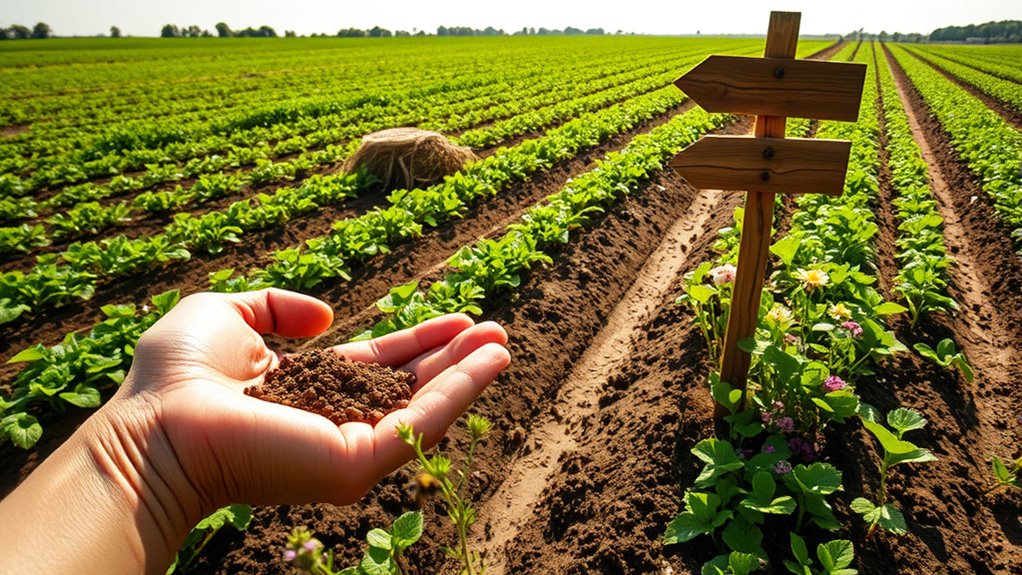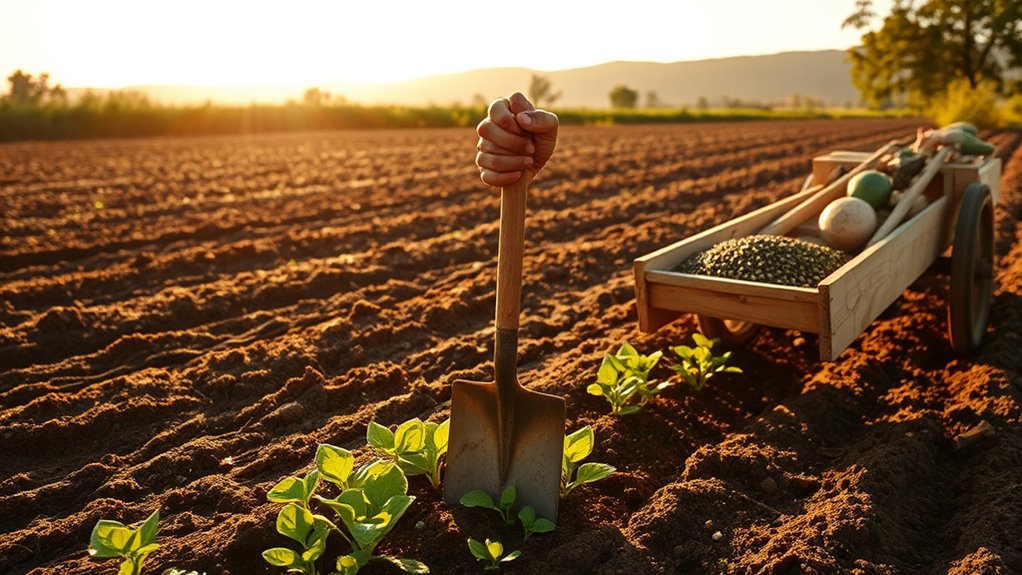Becoming a farmer with no money is doable if you leverage low-cost options like bee farming or microgreens. Start by minimizing initial investments and engaging with community resources for support. Gain skills through workshops and internships, and connect with local networks for collaboration. Look for financial assistance through USDA loans or grants. Focus on sustainable practices to boost profitability. There's a roadmap to success waiting for you, and the next steps could unlock more opportunities.
Key Takeaways
- Start small with low-cost options like bee farming or microgreens to minimize initial investment.
- Gain experience through community gardens, internships, and farmer training programs to build essential skills.
- Network with local farmers and participate in community events to leverage resources and support.
- Explore funding options like USDA loans, grants, and crowdfunding to secure financial assistance.
- Implement sustainable practices and direct-to-consumer sales to enhance profitability and grow your farm.
Starting Small: Minimizing Initial Investment

Starting your farming journey on a budget can be both rewarding and feasible, especially if you focus on low-cost options. Consider bee farming, microgreens, or hydroponics to keep initial investments low. For example, starting with a single beehive can cost around $800, while microgreens often require less than $500 for seeds and containers. Engaging in community resilience can significantly enhance your farming efforts by fostering support networks and sharing resources. Additionally, remember that chicken ownership considerations recommend starting with at least 3-4 chickens for social behavior, which can also add variety to your farming practice.
Leasing land instead of purchasing it can also save you money, costing only 5-10% of the land's value each year. Use minimal equipment by borrowing or sharing tools with fellow farmers. Conduct market research to identify profitable crops that meet local demand, and create a solid business plan to manage your finances effectively. Additionally, exploring options like honey gift sets can provide an extra source of income while adding value to your farming venture. Starting small can lead to significant rewards down the line.
Education and Training: Building Your Skills

Building your farming skills is a pivotal step toward success, especially when you're starting with limited resources.
Explore programs like Rogue Farm Corps or the Future Harvest Beginner Farmer Training Program, which offer immersive training and mentorship. You can gain hands-on experience through community gardens or farm internships, while also benefiting from classroom learning about soil management and pest control. Cultivating resilience through these experiences will help you adapt to the challenges of farming. Understanding financial considerations for elderly care can also be beneficial as you navigate the economic aspects of starting a farm.
Take advantage of online and in-person courses tailored to your schedule. Attend farm tours and discussions to deepen your understanding of practices.
Don't overlook business skills development—learning financial management and marketing is crucial. Additionally, understanding the importance of emotional intelligence in both farming and relationships can enhance your interactions with customers and fellow farmers.
With diverse training opportunities, from livestock management to sustainable practices, you'll be well-equipped to launch your farming journey.
Community and Networking: Leveraging Local Resources

While diving into farming may seem daunting without financial resources, leveraging community and networking opportunities can make a significant difference.
Start by participating in local markets to sell your produce and gather valuable customer feedback. Collaborate on projects with fellow farmers to share costs and enhance efficiency. Engaging in community events helps you build relationships and strengthen your network. Additionally, consider forming mixed herds of sheep and goats to diversify your farming efforts and maximize resources. This approach can also improve foraging efficiency as different animals can complement each other's grazing habits.
Seek out mentorship programs for guidance and connect with experienced farmers through online forums. Take advantage of local workshops to expand your knowledge and network.
Additionally, consider leasing land and sharing tools to minimize expenses. By tapping into local resources and community support, you can establish a solid foundation for your farming journey. Furthermore, food preservation techniques can help you maximize the use of your harvested crops and reduce waste.
Financial Assistance: Exploring Funding Options

Navigating the world of farming can feel overwhelming, especially when financial resources are tight, but there are numerous funding options available to help you get started.
The USDA provides various loans, including direct and guaranteed loans for family farmers, as well as microloans up to $50,000 for beginners. You can also explore grants like the Specialty Crop Block Grants and the Farmers Market Promotion Program to boost your income.
The USDA offers loans and grants, including microloans for beginners, to support your farming endeavors.
Additionally, many states offer agricultural development programs and local tax incentives. Don't overlook private funding options like SBA loans or crowdfunding.
Finally, consider alternative strategies like leasing equipment or forming partnerships to minimize initial costs. With the right resources, you can begin your farming journey successfully.
Sustainable Practices: Reducing Costs and Enhancing Profitability

After exploring various funding options to kickstart your farming journey, it's important to consider how sustainable practices can't only reduce your costs but also enhance your profitability.
Techniques like cover cropping and composting lower synthetic fertilizer needs, boosting soil health while cutting expenses. Although initial yield reductions may occur, practices like crop rotation can improve long-term productivity.
Embracing precision farming helps you optimize resources, minimizing waste and costs. Integrating alternative energy sources like solar power can further reduce operational expenses. Additionally, utilizing solar energy solutions can greatly enhance efficiency and lower your farm's energy bills.
By adopting these sustainable practices, you not only promote environmental health but also tap into market opportunities that often command higher prices.
In the long run, these strategies can significantly increase your farm's resilience and profitability.
Business Planning: Crafting Your Roadmap to Success

Crafting a solid business plan is crucial for your success as a farmer, as it serves as a roadmap guiding your decisions and strategies. Start with an executive summary that outlines your mission, goals, and key strategies.
In the business overview, detail your farm's structure and location. Conduct a thorough market analysis to identify your target market, assess demand, and evaluate competition.
Set clear short-term and long-term goals, and create action plans with specific tasks and deadlines. Establish milestones to track your progress and performance metrics to evaluate success.
Don't forget financial projections, including income statements and cash flow analysis, to ensure profitability. Finally, incorporate risk management strategies to mitigate potential challenges along the way.
Scaling Your Operation: Growing Gradually and Strategically

As you embark on your farming journey, scaling your operation gradually and strategically is essential for long-term success.
Start by embracing technology like precision farming and automated systems to optimize resources and boost efficiency.
Diversify your crops through rotation and specialty varieties to tap into lucrative markets while managing risks.
Strengthen your supply chain relationships by partnering with local businesses and leveraging cooperatives for better pricing.
Focus on financial planning by exploring grants and loans to access capital, while implementing budgeting to assess impacts on your operations.
Lastly, develop a strong brand identity and engage in direct sales to build customer loyalty and maximize your market presence.
Grow smartly, and you'll set a solid foundation for your farming future.
Frequently Asked Questions
What Crops Are Easiest to Grow for Beginners?
If you're just starting out, you'll want to choose crops that are easy to grow. Bell peppers, cucumbers, and tomatoes are great for beginners. They're relatively low-maintenance and yield delicious results.
For vegetables, consider planting green beans or zucchini, as they grow quickly and are productive. If space is tight, radishes and lettuce are perfect options.
You'll find that these crops boost your confidence and make gardening enjoyable!
How Can I Market My Produce Without a Budget?
You can market your produce without a budget by utilizing social media platforms like Facebook and Instagram to showcase your products.
Encourage your customers to share user-generated content, creating organic buzz.
Participate in local events and farmers' markets to connect directly with your community.
Collaborating with nearby businesses can also help you reach a wider audience.
Lastly, consider starting a blog or newsletter to share your story and engage with potential customers.
What Are Common Mistakes New Farmers Make?
New farmers often make several common mistakes. You might skip creating a solid business plan, leading to financial chaos.
It's easy to underestimate the importance of understanding your land and market dynamics. You might get overwhelmed by starting too many ventures at once or expand too quickly without stability.
Poor financial management, like overspending or ignoring market demand, can also hinder your success.
How Do I Find Local Agricultural Resources?
To find local agricultural resources, start by visiting your local extension office for workshops and technical assistance.
Join farmer associations for networking and market access.
Check community colleges for agricultural programs that offer training.
Explore online forums and social media groups where you can connect with other farmers.
Attend agricultural events like fairs and conferences to meet experts and gather valuable information.
Each resource can help you get started effectively!
Can I Start Farming Part-Time While Working?
Sure, you can start farming part-time while juggling a full-time job—because who doesn't want to add more to their plate?
Balancing both is a challenge, but many manage it successfully. You'll need to assess your available time and resources.
Opt for low-input crops and prioritize efficient practices. Embrace community collaboration for support, and you'll find that part-time farming can be a rewarding endeavor alongside your off-farm commitments.
Conclusion
Becoming a farmer with little to no money may seem daunting, but it's entirely possible with the right approach. Did you know that over 50% of new farmers start with less than $10,000? By starting small, building your skills, and leveraging community resources, you can turn your farming dreams into reality. Stay focused on sustainable practices and a solid business plan, and you'll be well on your way to a successful farming journey.










